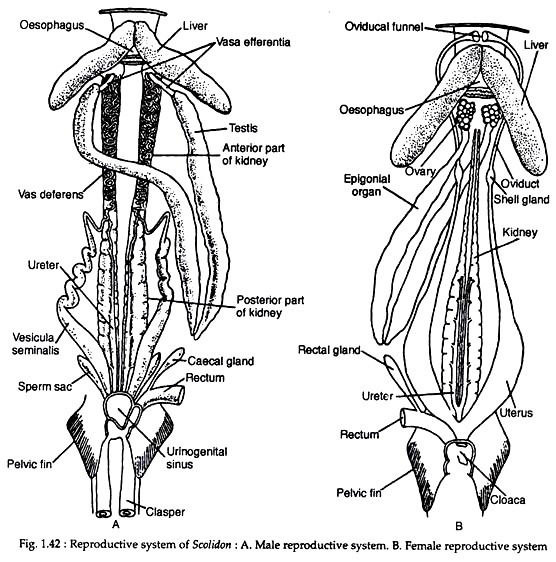In this article we will discuss about the male and female reproductive systems of scoliodon.
The excretory organ consists of a pair of elongated kidneys. The functional adult kidneys are opisthonephros type. The anterior portion of the kidney is non-functional and the posterior portion becomes greatly developed. The kidneys are composed of coiled glandular uriniferous tubules or nephrons. Each tubule consists of a double-walled cup (or Bowman’s capsule) enclosing glomerulus and a much coiled renal tubule.
A few renal tubules open into a common collecting tubule. The kidney tubules have the peculiar property of reabsorbing urea. The collecting tubules of the anterior non-renal portion of the kidney open to the Wolffian duct and the posterior tubules open into the ureter which in turn opens into the urinogenital sinus.
The mesonephric duct divides into two. The dorsal one is named as Wolffian duct and the ventral one is the Mullerian duct. The Wolffian duct in males becomes the vas deferens which is connected with the vasa efferentia from the testis. The Mullerian duct becomes the oviduct in females.
ADVERTISEMENTS:
The kidneys are extremely elongated structures extending from the root of the liver to the cloacal region. The posterior portion is designated as the kidney proper and it is greatly developed. The anterior portion becomes narrower and takes part in conveying the genital products in male. This part is designated as the organ of Leydig or epididymis.
Male Reproductive System:
The testes are paired elongated organs (Fig. 1.42A). Each testis is attached to the dorsal body wall by peritoneal membrane called mesorchium and posteriorly attached by ordinary tissue with the caecal gland. The sperm cells escape by vasa efferentia into the vas deferens which becomes extremely coiled in the anterior portion of the kidney.
Posteriorly the vas deferens becomes very much dilated to form the seminal vesicle. The seminal vesicles open into the urinogenital sinus which in turn opens into the cloaca. The wall of the urinogenital sirus has become evaginated to form a sperm sac.
Female Reproductive System:
In females there is no connection between the kidneys and the genital organs. The kidneys are typical excepting that the ureters unite posteriorly and open by a single urinary aperture into the urinary sinus. The ovaries are two in number and are kept in position by peritoneal folds called mesovarium.
ADVERTISEMENTS:
The shape, size and colour of the ovaries vary greatly according to the age of the individual. A pair of epigonial organs are present between the ovary and the rectal gland. The oviducts are very long tubes and remain united both posteriorly and anteriorly (Fig. 1.42B).
Posteriorly, two oviducts unite to form the vagina which opens into the cloaca. Anteriorly, the oviducts converge and open into the coelomic cavity by a longitudinal slit-like opening designated as oviducal funnel. At the anterior portion of each oviduct there is a dilated shell gland which has little significance in Scoliodon.
As Scoliodon is viviparous the posterior portion of the oviduct becomes dilated to form the uterus for the development of the young. The number of embryos present inside one uterus vary greatly in different species of Scoliodon. The mucous membrane of the uterus becomes divided into a number of compartments each of which houses an embryo. The number of compartments vary directly with the number of embryos.
The eggs are large and heavily yolked. Each egg gets a coating of albumen during its transit down the oviduct. The egg, particularly in oviparous forms, is enclosed by horny shell which is oblong in shape.
